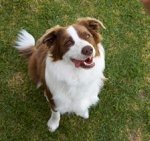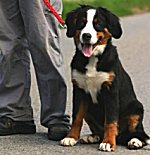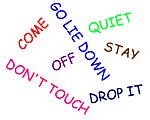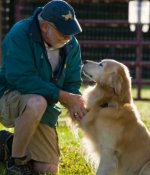Pulis: What's Good About 'Em, What's Bad About 'Em
Puli temperament, personality, training, behavior, pros and cons, advice, and information, by Michele Welton, Dog Trainer, Behavioral Consultant, Author of 15 Dog Books
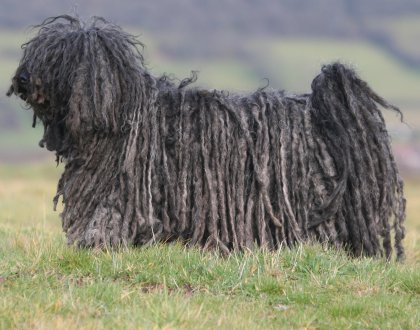
The acrobatic Puli has been likened to a bouncing spring. Typically he remains lively and playful well into his teens. With boundless energy and insatiable curiosity, he bustles about with light-footed agility, checking out every new sight and sound – and expressing his opinion about it.
The Puli is a sturdy herding breed, a superb athlete with quick reflexes. He can turn on a dime and clear a six-foot fence from a standstill.
With his keen eyesight, acute hearing, and suspicion of strangers, the Puli is serious about his responsibility as a watchdog. He will rush up to a stranger to take his measure and is willing to back up his loud warning bark with a bite. Since dogs are not the best judges of a person's true intentions, you could end up in legal (and financial) hot water if your Puli bites someone. Extensive socialization is required to keep a Puli from becoming too sharp.
Some Pulis are playful with other dogs, while other Pulis are dominant, bossy, and territorial. His high prey drive will send him in rollicking pursuit of small creatures that run.
One of the smartest of all breeds, supremely self-confident, the Puli is also one of the most demanding and manipulative. As one breeder puts it, the Puli has "a capacity for causing mischief that is truly awesome."
This breed is for experienced owners who know how to lead a strong-willed dog. The Puli has an "in your face" personality and is accustomed to making his own decisions. He will continue to do so unless you take control with firm leadership and consistent rules. Yet he is also proud and sensitive and won't tolerate harsh handling.
If you want a dog who...
- Is conveniently sized, sturdy and durable, athletic and agile
- Has a long shaggy coat (can be clipped short)
- Sheds less than many other breeds (because shed hairs are trapped in the long coat)
- Has been likened to a bouncing spring – energetic and curious
- Thrives on exercise and athletic activities
- Has a self-possessed, confident attitude
- Makes an extremely keen watchdog
A Puli may be right for you.
If you don't want to deal with...
- Vigorous exercise requirements
- Suspiciousness or aggression toward strangers when not socialized enough
- Aggression toward other animals – chasing instincts
- Strong-willed mind of his own, requiring a confident owner who can take charge
- Barking
- LOTS of grooming/maintenance of the long coat (or clipping it short)
- "Shaggy dog syndrome," i.e. debris clinging to the coat, water soaking into the beard and dripping on your floors
- Waiting lists (hard to find) and a high price tag
A Puli may not be right for you.
 |
Dog Breed Traits – Which Traits Are Right For You? In this brand new series, I'll help you decide which dog breed traits would best suit you and your family, your home and yard, and your lifestyle, so you can choose the best dog breed for your family. |
Keep in mind that the inheritance of temperament is less predictable than the inheritance of physical traits such as size or shedding. Temperament and behavior are also shaped by raising and training.
FREE eBooks by Michele Welton
![]() "Respect Training for Puppies" and "Teach Your Dog 100 English Words" are free step by step guides to teaching your pup to be calm and well-behaved.
"Respect Training for Puppies" and "Teach Your Dog 100 English Words" are free step by step guides to teaching your pup to be calm and well-behaved.
![]() "11 Things You Must Do Right To Keep Your Dog Healthy and Happy" is a free guide to keeping your dog mentally, physically, and emotionally happy and healthy so you can enjoy a longer lifetime of companionship.
"11 Things You Must Do Right To Keep Your Dog Healthy and Happy" is a free guide to keeping your dog mentally, physically, and emotionally happy and healthy so you can enjoy a longer lifetime of companionship.

More traits and characteristics of the Puli
If I was considering a Puli, I would be most concerned about...
- Providing enough physical – and mental – exercise. Pulis don't need miles of running exercise. But they must have several daily walks and a fenced yard in which to stretch their legs and romp. Just as important as physical exercise is mental exercise, which means interesting activities to do. Pulis are intelligent herding dogs who like to keep busy.
I recommend that you get your Puli involved in regular obedience classes (beyond the beginners level – join a dog club and go every week). Also consider agility classes (an obstacle course for dogs) or even herding, if there is a herding club in your area. Also check out my free online book, Teach Your Dog 100 English Words, because teaching your dog words and games stimulates his brain and keeps him happy!
- Suspiciousness. Most Pulis have protective instincts toward strangers. They need extensive exposure to friendly people so they learn to recognize the normal behaviors of "good guys." Then they can recognize the difference when someone acts abnormally. Without careful socialization, they may be suspicious of everyone, which could lead to biting.
- Chasing other animals. The Puli is usually fine with the pets in his own family. But he can be a bit pushy toward dogs he doesn't know, and he will pursue small animals that run.
- Mind of their own. Pulis are very smart and very trainable – in the right hands. But they have an independent mind of their own (as do most herding breeds) and can be willful and manipulative. You need to know what you're doing or a Puli will walk all over you. To teach your Puli to listen to you, "Respect Training" is mandatory. Follow my free online training programs.
- Barking. Pulis can be serious barkers, and their voice is loud and strong.
- Grooming. If you want your Puli to look anything like the pictures in dog books and on TV, you'll be spending an enormous amount of time and energy in coat care. The wiry hairs of his outer coat tend to fuse with the wooly hairs of his undercoat to form felt cords. If you wish to keep this appearance, you must separate the cords every few weeks. Bathing takes a half hour, for the cords must be thoroughly rinsed. Drying takes 24 hours, with the dog in a crate surrounded by a dryer and box fans.
Your second option is to brush out the cords whenever they start to form. This produces a natural "shaggy" look that simply requires lots of regular brushing. Your third option is to keep the coat trimmed or clipped so it's short and sanitary. This is my favorite option.
- "Shaggy dog syndrome." Like all shaggy dogs, the Puli is a messy dog. Leaves, mud, snow, fecal matter, and other debris cling to his rough coat and ends up all over your house. When he drinks, his beard absorbs water, which drips on your floors when he walks away. When he eats, his beard absorbs food so that when he sniffs your face or presses his head against your leg, YOU end up dirty, too. Shaggy dogs are not suited to fastidious housekeepers.
Again, clipping the coat makes all of these hassles go away.
- Shedding. Pulis definitely shed, though much of the shed hair gets caught in the long coat rather than ending up on your floor. But if you clip the coat, of course, there is no longer an impediment to the shed hair falling out. But it's not a ton of hair, so I think the trade-off (an easy-care coat) is worth it.
- Finding one and paying the price. In the United States, only a couple of hundred Puli puppies are registered each year. Be prepared to go on a waiting list and to pay pretty much whatever the breeder wants to charge.
My best-selling books – now available FREE on my website
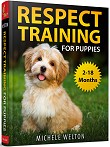 Respect Training For Puppies: 30 seconds to a calm, polite, well-behaved puppy is for puppies 2 to 18 months old. Your puppy will learn the 21 skills that all family dogs need to know. Click here to read for free.
Respect Training For Puppies: 30 seconds to a calm, polite, well-behaved puppy is for puppies 2 to 18 months old. Your puppy will learn the 21 skills that all family dogs need to know. Click here to read for free. Teach Your Dog 100 English Words is a unique Vocabulary and Respect Training Program that will teach your adult dog to listen to you and do what you say. Click here to read for free.
Teach Your Dog 100 English Words is a unique Vocabulary and Respect Training Program that will teach your adult dog to listen to you and do what you say. Click here to read for free. 11 Things You Must Do Right To Keep Your Dog Healthy and Happy helps your dog live a longer, healthier life. Get my honest advice about all 11 Things before you bring home your new puppy, because some mistakes with early health care cannot be undone. Click here to read for free.
11 Things You Must Do Right To Keep Your Dog Healthy and Happy helps your dog live a longer, healthier life. Get my honest advice about all 11 Things before you bring home your new puppy, because some mistakes with early health care cannot be undone. Click here to read for free.Related posts you might enjoy



